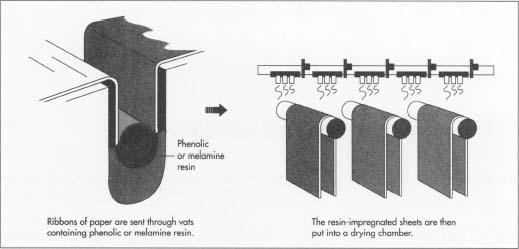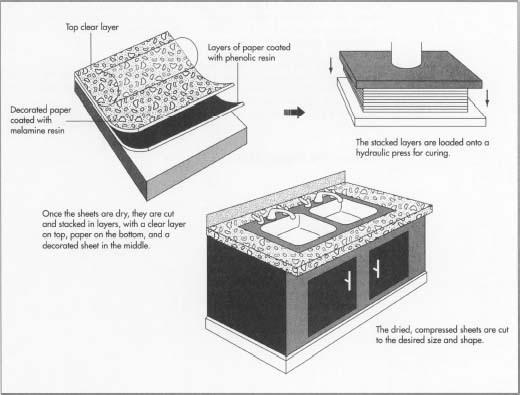Decorative Plastic Laminate
Background
Decorative plastic laminate is a durable flat sheeting material used in home and industrial furnishings. It is most familiar under the Formica brand name. The Formica Corporation is the world's largest manufacturer of plastic laminate. Other well known manufacturers include the Premark Corporation and DuPont.
Decorative laminate is commonly used to surface kitchen counters, table tops, and cabinetry because of its resistance to stains, scratches, and heat. The laminate sheets are made up of three layers: the bottom layer of brown paper coated with phenolic resin, a second layer of paper decorated with the desired pattern, and a third layer of clear sheet. Both the second and third layers are coated with melamine resin.
History
Plastic laminate was first used as an insulating material for industrial products. Its invention is credited to two engineers, Herbert A. Faber and Daniel J. O'Conor. In the early 1900s, these two joined the Westinghouse company in Pittsburgh as part of a dream team of scientists working on insulating material and phenolic laminate resins. Phenolic laminate resins had been developed around this time by the Belgian chemist Leo Baekeland. Baekeland condensed phenol and formaldehyde to produce the first totally synthetic plastic, Bakelite. The material was resistant to heat, water, chemicals, and electric current, thus having the properties to replace hard rubber and shellac for electrical insulation. Baekeland's many experiments included impregnating paper with Bakelite resin and then compressing it under molds at high pressure and temperature in a process known as ther-mosetting. The two Westinghouse engineers worked in this same vein. They began by impregnating heavy canvas with Bakelite resin, and by 1913 they had applied for a patent for a flat laminate sheet made from Bakelite and paper. Faber called the new plastic laminate formica: "for" (in place of) "mica" (mineral used as electrical insulation material).
Faber and O'Conor left Westinghouse to found their own company in 1913, the Formica Insulating Company in Cincinnati, Ohio. The new company produced rings and tubes of plastic laminate for electrical insulating purposes, but by 1914, Faber and O'Conor were using a press to churn out flat laminate sheets. The laminate was widely used in radio sets in commercial shipping and naval vessels to insulate coils, tuners, and other parts. But plastic laminate was soon used for its decorative properties as well because its flawless, uniform character was the perfect radio exterior. By 1921, the laminate manufactured by the Formica Insulating Company had been integrated into the manufacture of home radios as well as ship radios.
In 1927, Faber and O'Conor discovered that by adding decorative paper through a lithographic printing process, their laminates could be made with patterns that simulated wood grains and marble. As the laminate became more colorful and decorative, its market expanded. Faux marble laminate was popular for soda fountains in the 1930s, and a woodgrain laminate was used in place of aluminum inside airplanes in the

Raw Materials
Decorative plastic laminate sheeting is made of resins that react with aldehydes during the thermosetting process. The resins are laminated onto layers of kraft paper topped with a decorative sheet. Kraft paper is the same brown paper used in grocery bags. The first plastic laminates were made with phenolic resin, a polymer of formaldehyde and phenol. Phenolic resins produce only dark colors. In the 1930s, a urea-based resin called melamine was developed that produced a clear surface. In the modern manufacturing process, the top two layers of paper are impregnated with melamine resin, and the lower layers use phenolic.
The Manufacturing
Process
Impregnating the paper
- 1 The process begins by soaking strips of paper in resin. Decorative plastic laminates can be made in different grades or thicknesses, depending on its intended use. There may be from 7-18 layers of paper combined into the final sheet. The bottom layers are kraft paper. The paper comes in ribbons of different widths, commonly of three, four, or five feet. The kraft paper is run through a "bath tub" or vat containing phenolic resins. The paper for the top layer of the sheet is translucent. This is run through a vat of melamine resin. The layer just beneath the top is the decorative layer. This is a sheet of paper printed with the color or design that will show through the clear top layer for the desired surface pattern. This sheet is also run through a melamine vat.
Drying
- 2 The resin-impregnated sheets are then put into a drying chamber. Next, they are cut and stacked in layers. The clear layer and the decorative layer are on top of the kraft paper.
Thermosetting
-
3 The layers of paper are then loaded onto a flat-bed hydraulic press
for final curing. The press compresses the sandwich of resin-soaked
paper at 1,400 psi, while heating it to a high temperature. The heat
catalyzes a reaction in the resins. The phenol (or melamine) and
formaldehyde molecules
attach to each other in an alternatingchain fashion, releasing water molecules in the process. The resins flow together and then set. Thermosetting converts the paper sheets into one single, rigid laminated sheet. This sheet is dry and insoluble, and it cannot be shaped or molded, even at high temperatures.

Finishing
- 4 The dry sheet is cut into the desired size and shape. It may also be bonded to a building material such as plywood, flakeboard, fiberboard, or metal.
Byproducts/Waste
The plastic laminate manufacturing process produces several byproducts, some of which are considered hazardous. Toxic emissions emanate from phenolic resins during the laminating process, and acrylic resins and hardeners used in applying plastic laminates to surfaces are also considered hazardous. Decorative plastic laminate itself is not considered a "recyclable" plastic. However, at least one major manufacturer has taken steps to reduce harmful waste and emissions. By switching from solventbased to water-based phenolic resins, the amount of toxins released during lamination can be reduced. Recent changes in the composition of melamine have also virtually eliminated alcohol emissions from this type of resin as well. Control devices such as so-called packed column scrubbers also reduce particulate emissions into the air.
Paper and laminate residue generated during the manufacturing process are burned in power boilers. This reduces the amount of waste sent to landfills. Metal-based pigments used in decorative papers also create a waste problem, as these can be hazardous. The leading manufacturer of plastic laminate has for this reason reduced the use of such pigments, and plans to totally eliminate the use of metal-based pigments in the future. Although used laminate is not recyclable, some companies have collated old laminates into new sample sets suitable for distribution.
Where To Learn More
Books
Cowie, J.M.G. Polymers: Chemistry and Physics of Modern Materials, 2nd edition. Chapman and Hall, 1991.
Lewin, Susan Grant, ed. Formica and Design: From the Counter Top to High Art. Rizzoli International Publications, 1991.
Periodicals
Jones, Thomas H. "Repairing Plastic Laminate." Home Mechanix, April 1990, p. 18+.
Wicks, Harry. "Working with Plastic Laminates." Home Mechanix, August 1988, p. 25+.
— Evelyn S. Dorman
Can I have some detail on Water Based Phenolic Resin ? Its formulations, name of manufacturers, if any ?